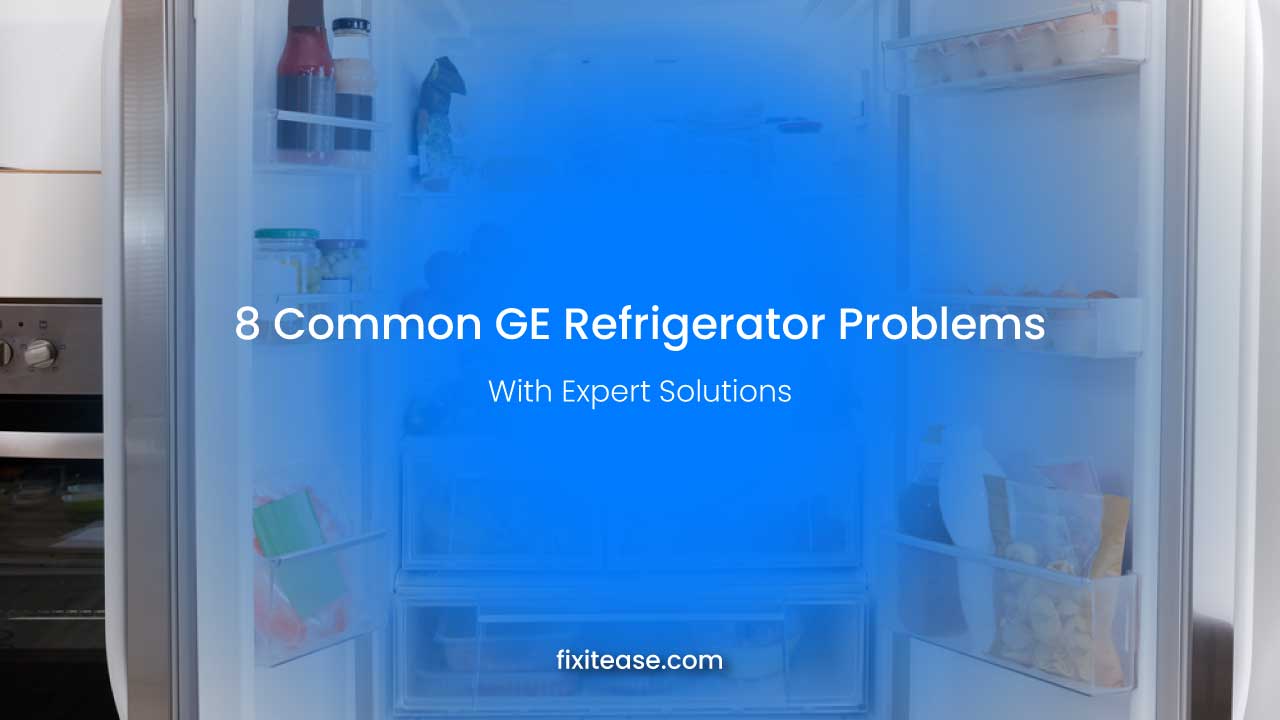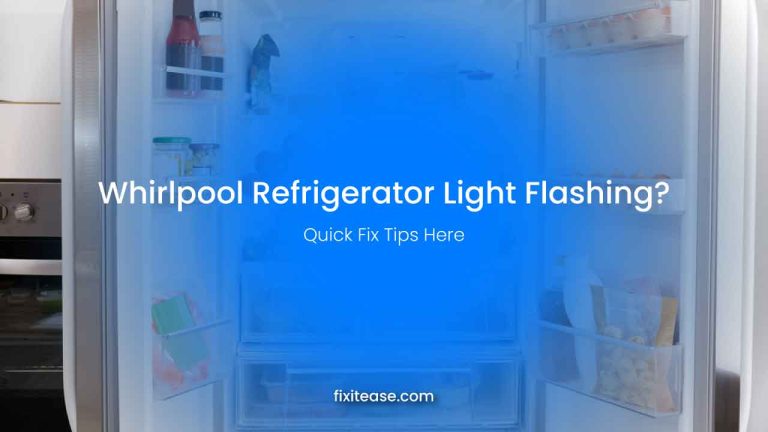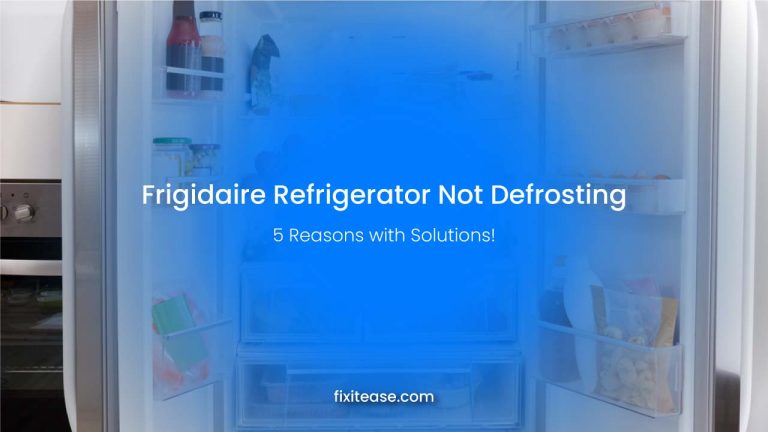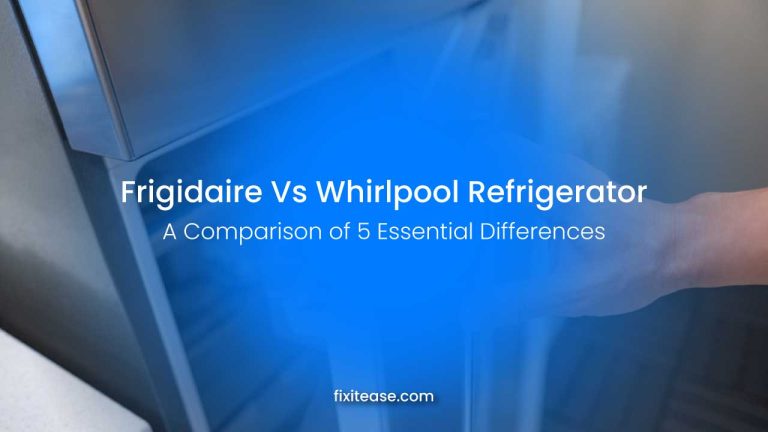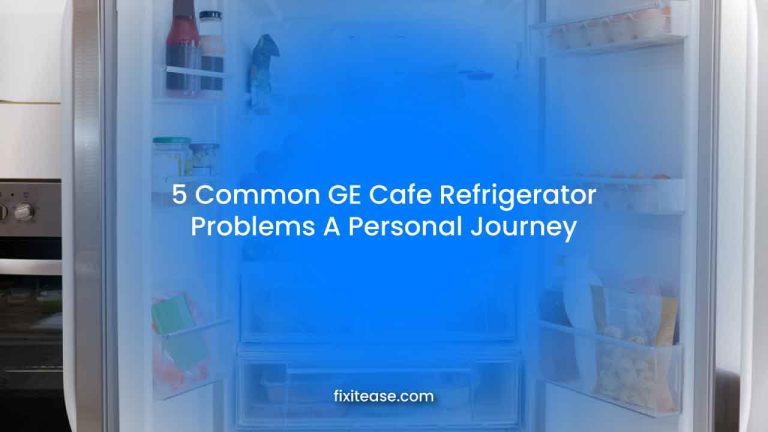8 Common GE Refrigerator Problems [With Expert Solutions]
Dealing with a GE refrigerator hiccup is frustrating, but fear not; solutions are at hand. My guide on troubleshooting common issues is here to ease your appliance woes.
I’ve always believed that understanding your home appliances is essential to a smoother daily life. That’s why I’m sharing insights on the typical problems you might face with your GE refrigerator. I’ve covered everything from cooling inefficiencies to unexplained noises, water dispenser leaks, and ice maker glitches.
Each issue is paired with practical, easy-to-follow solutions to get your fridge back in shape. Whether you’re a DIY enthusiast or just seeking a better understanding of your appliance, this guide is tailored for you. So, let’s unravel these refrigerator mysteries together and keep your kitchen running seamlessly!
Table of Common Problems with GE Refrigerators, Reasons, and Solutions:
Here is a quick reference for troubleshooting these issues.
| Common Problems | Reasons | Solutions |
| Insufficient Cooling | Incorrect thermostat settings, Dirty condenser coils, Blocked vents, Damaged door seal | Adjust the thermostat, Clean condenser coils, Rearrange contents, Replace seal |
| Unusual Noises | Loose internal components, Faulty motor or compressor, Defrost timer issues | Tighten loose parts, Inspect and possibly replace motor or compressor, and Check to defrost timer |
| Water Dispenser Issues | Worn out parts, Low water pressure, Clogged water filter | Replace parts like valves and seals, Check home water pressure, Replace the water filter |
| Ice Maker Malfunctions | Clogged water line, Faulty ice maker assembly, Low water pressure | Unclog or replace water line, Repair or replace ice maker assembly, Ensure adequate water pressure |
| Defrosting Problems | Faulty defrost heater, Malfunctioning defrost thermostat or timer, Poor door sealing | Replace defrost heater, Check and replace thermostat or timer if needed, Fix or replace door seal |
| Interior Lighting Problems | Burned-out bulb, Faulty door switch | Replace the bulb, Replace the door switch |
| Door Closure Difficulties | Misaligned hinges, Damaged or dirty seals | Adjust or tighten hinges, Clean or replace seals |
| Additional Considerations (Odor, Warmth) | Bacterial growth or lingering food particles, Inadequate ventilation or cooling system issues | Thorough cleaning, especially in hidden areas, Check ventilation and cooling system |
GE Refrigerator Problems: 8 Effective Solutions to Try Today!
GE refrigerators, renowned for their quality and durability, are not immune to problems. If you can understand these common problems, you can effectively troubleshoot and ensure the longevity of your refrigerator. Now, let’s look at these issues in detail and insights into their causes, symptoms, and potential solutions.
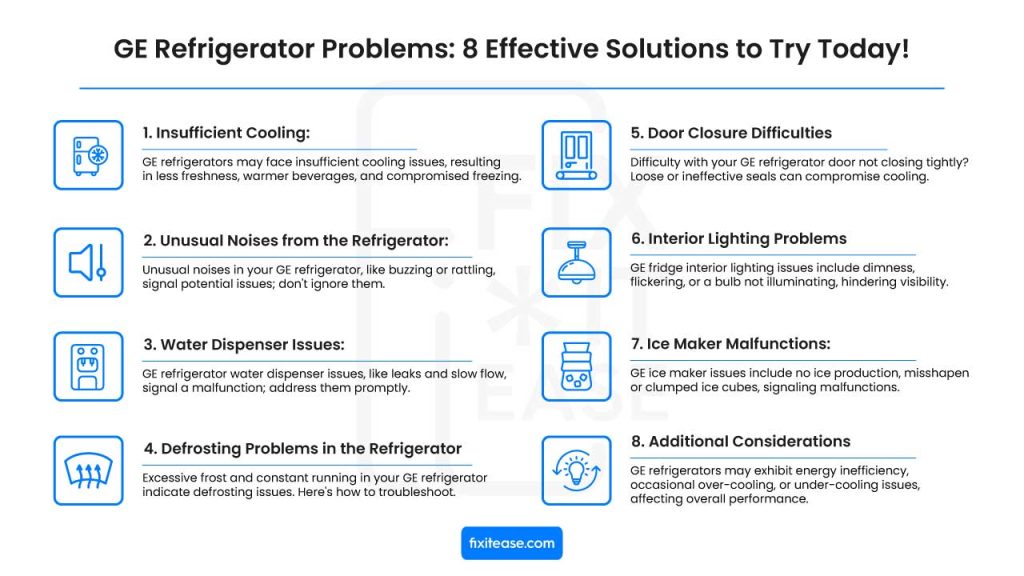
1. Insufficient Cooling:
Insufficient cooling is one of the most common issues with a GE refrigerator. This problem can crop up for several reasons. Food isn’t as fresh as it should be, and beverages are not as cold as usual.
The freezer section might not keep items thoroughly frozen, or there could be noticeable temperature fluctuations within different fridge parts. These signs suggest that your refrigerator isn’t maintaining the optimal temperature.
Problems:
- Thermostat Setting Too High: Sometimes, the issue is that the thermostat is set higher than needed. This means your fridge isn’t cooling as much as it should.
- Dirty Condenser Coils: The coils at the back of your fridge release heat. When they’re covered in dust, your fridge can’t cool properly.
- Blocked Air Vents: Cold air can’t circulate well if your fridge is too full or items block the vents.
- Worn Door Seal: A damaged or dirty seal around the door lets cold air escape, making your fridge work harder to stay cool.
Solutions:
- Adjust the Thermostat: Let the setting a bit to see if that helps. It’s a simple tweak.
- Clean the Coils: Unplug the fridge and gently clean the coils with a brush or vacuum.
- Rearrange the Fridge: Make sure there’s space around items for air to move. Keep vents clear.
- Check the Door Seal: Clean it with soapy water or replace it if it’s damaged. This can help with cooling.
2. Unusual Noises from the Refrigerator:
If your GE refrigerator starts making unusual noises, it’s often an unmistakable sign that something’s not quite right. These sounds vary, ranging from unexpected loud buzzing or humming to intermittent clicking or rattling. Such noises are not just disruptive; they’re indicators of potential issues within your fridge.
Types of Strange Noises:
- Buzzing or Humming: This can happen when the fridge is running its cooling cycle.
- Clicking Sounds: Often caused by the defrost timer or the compressor turning on and off.
- Rattling: This could be from loose items in or around the fridge.
Troubleshooting Sound Issues:
- Check for Loose Items: Make sure there’s nothing on top of or behind the fridge that could vibrate.
- Inspect the Defrost Timer and Compressor: If these parts are the issue, they might need adjusting or replacing.
- Secure Internal Components: Sometimes, shelves or drawers inside the fridge can rattle. Make sure everything is firmly in place.
3. Water Dispenser Issues:
When your GE refrigerator’s water dispenser starts giving trouble, the symptoms are usually easy to spot. You might notice water dripping or leaking from the dispenser when it’s not in use, or the water flow could be slower than usual, trickling out instead of flowing freely. These issues can be annoying and wasteful, signaling that something is amiss with the dispenser system.
Problems:
- Dripping or Leaking: This can happen if the dispenser parts are worn out or not fitted properly.
- Slow Water Flow: This might be due to a clogged water filter or low water pressure in your home.
Solutions:
- Check and Replace Parts: Inspect the dispenser for worn-out parts, like the valve or seal, and replace them if needed.
- Change the Water Filter: A clogged filter can restrict water flow, so changing it regularly can solve slow flow issues.
- Inspect Water Pressure: Ensure your home’s water pressure is strong enough for the dispenser to function properly.
4. Defrosting Problems in the Refrigerator
If you’re noticing too much frost in your GE refrigerator, or it seems to be running non-stop, you might be dealing with defrosting issues. These problems can cause your fridge to work harder than it should, leading to other complications. Let’s break down how to identify and fix these defrosting problems.
Identifying Defrosting Issues:
- Excessive Frost Build-up: You’ll see more frost than usual, especially around the evaporator coils.
- Fridge Running Constantly: The fridge doesn’t cycle off as it’s trying to maintain the right temperature despite the frost.
Addressing Defrosting Malfunctions:
- Check the Defrost Heater: This part melts away frost. If it’s not working, it may need replacing.
- Inspect the Defrost Thermostat and Timer: These components regulate the defrost cycle. If faulty, they could cause frost accumulation.
- Ensure Proper Door Sealing: A bad seal can sometimes let in humid air, leading to extra frost. Make sure the door seals are clean and tight.
5. Door Closure Difficulties
Having trouble with the door of your GE refrigerator not closing properly is a common issue, and it’s easy to spot. You might notice the door feels loose or doesn’t seal tightly, leading to cold air escaping. This affects your fridge’s cooling efficiency and can lead to increased energy bills.
Reasons for Door Closure Difficulties:
- Misaligned Hinges: Over time, the door hinges can become misaligned, preventing the door from shutting properly.
- Damaged or Dirty Seals: The rubber seal around the door, known as a gasket, can get dirty or wear out, causing air leaks.
Solutions:
- Adjust or Tighten Hinges: Check and adjust or tighten the hinges to realign the door.
- Clean or Replace Seals: Clean the seals with soapy water to remove grime. If the seal is damaged, it might need replacing to ensure a tight closure.
6. Interior Lighting Problems
Interior lighting problems in GE refrigerators are easy to identify – you open the fridge, and it’s darker than usual. The light bulb might not turn on or flicker and doesn’t provide steady illumination. This issue can make it hard to see inside your fridge, especially at night, and can be a nuisance when trying to find items.
Reasons for Interior Lighting Problems:
- Burned-out Bulb: The most common reason is simply a bulb that has reached the end of its life.
- Faulty Door Switch: If the switch that turns the light on when you open the door is malfunctioning, the light won’t activate.
Solutions:
- Replace the Bulb: Unscrew the old bulb and screw in a new one. Make sure to use the right bulb for your model.
- Check and Replace the Door Switch: Inspect the door switch if the bulb is fine. If it’s not working, replacing it should fix the problem.
7. Ice Maker Malfunctions:
When your GE refrigerator’s ice maker starts acting up, the signs are clear. You might find your freezer devoid of ice, or the ice that does come out could be misshapen, stuck together in clumps, or just not the right size.
These symptoms are telltale indicators that something’s not quite right with the ice-making process. Whether it’s a complete halt in ice production or ice cubes that don’t look like they should, these issues can be a real inconvenience in your daily routine.
Problems:
- Stopped Producing Ice: This could be due to a clogged water line or a faulty ice maker assembly.
- Oddly Shaped or Clumped Ice: Often caused by a malfunctioning water inlet valve or low water pressure.
Solutions:
- Check and Unclog Water Line: Ensure the water line to the ice maker isn’t blocked and clear any clogs if present.
- Inspect Ice Maker Assembly: Sometimes, parts of the ice maker assembly might need repair or replacement.
- Examine the Water Inlet Valve: Make sure the valve functions correctly and replace it if necessary.
- Assess Water Pressure: Low water pressure can affect ice production, so ensure your home’s water pressure is adequate.
8. Additional Considerations
Some considerations can arise in GE refrigerators beyond the usual defrosting issues. The fridge is not as energy-efficient as it used to be, using more electricity and still not performing optimally.
There could also be occasional over-cooling or under-cooling in different compartments, affecting food preservation. These symptoms can be confusing and frustrating but are often solvable with a few checks and adjustments.
Other Common Problems:
- Energy Efficiency Decline: This could be due to worn-out components or a build-up of dust and debris around the condenser coils.
- Inconsistent Temperature Control: Often caused by faulty sensors or control boards that regulate the temperature.
- Unusual Odors: Odd smells can emerge from lingering food particles or bacterial growth in hard-to-clean areas.
- Exterior Warmth: The sides or back of the fridge feeling warmer than usual could indicate issues with the cooling system or overworking of the compressor.
Solutions:
- Regular Maintenance: Cleaning the condenser coils and ensuring routine maintenance can improve energy efficiency.
- Sensor and Control Board Check: Inspecting and possibly replacing sensors or the control board can restore proper temperature regulation.
- Thorough Cleaning: Regularly cleaning the interior, including hidden and hard-to-reach areas, can prevent odor buildup. Using a mixture of baking soda and water can neutralize odors.
- Inspect the Cooling System: Ensure that the condenser coils are not clogged and that the fridge has adequate space around it for air circulation to avoid overheating.
- Check Ventilation: Proper ventilation around the fridge is crucial. Ensure it’s not pushed too close to walls or cramped in a tight space.
FAQs
Why is my GE refrigerator not cooling properly?
Insufficient cooling in GE refrigerators can stem from several issues. Check the thermostat settings first; it might be set higher than necessary. Dirty condenser coils are another common culprit; they should be cleaned regularly to ensure efficient cooling.
Also, ensure that the fridge is not overpacked and the air vents are not blocked, which can obstruct air circulation. Lastly, a damaged door seal might allow cold air to escape, so inspect and replace it if needed.
What causes unusual noises in my GE refrigerator?
Strange noises like buzzing, humming, or clicking usually point to internal mechanical issues. Loose components can vibrate and make noise, so check for any loose parts. If the noise comes from the back, it could be the compressor or the motor; these may need professional inspection or replacement. Also, a faulty defrost timer can create clicking sounds.
Why is the water dispenser on my GE fridge leaking or dripping?
Leaks or drips from the water dispenser often result from worn-out valves or seals. Over time, these components can degrade and fail to prevent water leakage. Another reason could be high water pressure in your home’s system, which can force water out of the dispenser. Regular maintenance and part replacements can resolve these issues.
What should I do if my GE fridge’s ice maker stops making ice?
If your GE refrigerator’s ice maker stops producing ice, check for a clogged water line first; this is a common issue. Also, a faulty ice maker assembly might need repairing or replacing. Ensure your home’s water pressure is adequate, as low pressure can affect ice production.
How do I fix defrosting problems in my GE refrigerator?
Defrosting issues, like excessive frost build-up, often occur due to a faulty defrost heater or a malfunctioning defrost thermostat or timer. These components are responsible for melting away frost, and if they fail, frost accumulates. Replacing these parts usually solves the problem. Additionally, ensure the fridge door seals properly to prevent frost accumulation.
What are some additional considerations for maintaining my GE refrigerator?
Beyond the common mechanical issues, watch for unusual odors or exterior warmth, as these can indicate hidden problems. Regular cleaning, especially in hard-to-reach areas, can prevent odor build-up. Ensure proper ventilation around your fridge to avoid overheating and maintain its efficiency. Regular maintenance checks and promptly addressing issues can extend your GE refrigerator’s life and performance.
Conclusion
Navigating the common problems with GE refrigerators can be a journey, but it’s manageable. Each challenge might initially seem daunting, from cooling issues to unexpected noises. But as we’ve seen, there are practical and doable solutions for each hiccup.
Remember, keeping your fridge in top shape isn’t just about immediate fixes; it’s also about understanding and caring for your appliance regularly. So, next time your GE fridge throws a curveball, you’ll know what to do.

